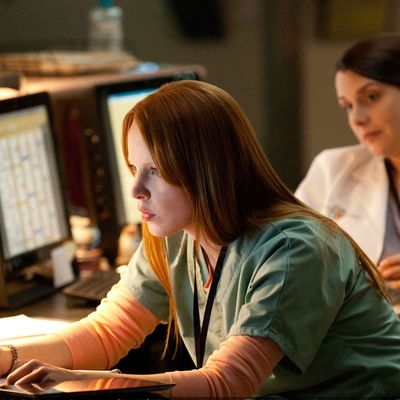
“Please don’t take me to Memorial,” gasps a bloodied patient in Coma, right after sinister orderlies load him into the back of an ambulance. They don’t listen. This is horror, and in horror, what you fear most is what happens to you.
This A&E miniseries is exuberantly batty. Loosely based on Robin Cook’s 1977 novel and the Michael Crichton film that followed (and produced by director Ridley Scott and his late brother Tony), it’s about an intern named Susan Wheeler (Lauren Ambrose) and a surgical resident named Mark Burroughs (Steven Pasquale) who think it’s weird that so many Peachtree Memorial patients end in comas and decide to poke around. Each new scrap of data ramps up their paranoia. Why did that doctor hang himself after one of his patients went comatose? Who paid off that malpractice plaintiff with nearly half a million dollars? Is the ebullient Professor Hillside (Richard Dreyfuss) — who was friends with Susan Wheeler’s famous heart-surgeon granddad back in the seventies — on the side of right? Or he loyal to Dr. Lindquist (Geena Davis), the head of psychiatry at Peachtree and Mark’s secret cougar booty call?
What about Mrs. Emerson (Ellen Burstyn), the head of the Jefferson Institute, a coma-patient care facility in which sleepers are wrapped in seventies sci-fi-looking jumpsuits and faux-laid in state in what appears to be Dave Bowman’s old bedroom? When the arrogant but powerful Dr. Stark (James Woods) asks Susan to find out everything he can about the conspiracy and relay it to no one but him, is he protecting her, or paving the way for her to end up — dun dun DUHNNNNNNN! — in a coma?!?
Like American Horror Story — and like Lars von Trier’s hospital horror miniseries The Kingdom, which the filmmakers must have studied — Coma is a soap opera from hell. It looks like a German Expressionist “Rebuild Detroit” ad and hypes up already-tense scenes with synthesized burbles, groans, and chants. Screenwriter John J. McLaughlin and director Mikael Solomon treat Susan’s dark adventures as an opportunity to stage dozens of haunted-house-style shocks, but not all at once. The catalogue approach to phobias reminded me a little bit of Poltergeist, which could have been titled If It Scares You, It’s Probably in Here. Murderous doctors and nurses? Check. Deranged stalker in a deserted building? Yes. Tendrils sprouting from walls like the candelabra hands in Jean Cocteau’s Beauty and the Beast? Surprisingly, yes.
The performances are in Hammer Horror mode: big, but not too big. You couldn’t ask for a more appealing hero than Pasquale’s earnest, sarcastic Mark or a more pleasing heroine than Ambrose’s relentless Susan. Woods is a stitch as Dr. Stark, a blowhard whose ego enters rooms before he does. Dreyfuss’s professor seems honest, then deceptive, then honest again; he’s hard to get a handle on, which is as it should be. As Mrs. Emerson, Ellen Burstyn seems to be channeling two characters from Night of the Hunter, Lillian Gish’s angel of mercy and Robert Mitchum’s sadistic preacher; she drawls like a Tennessee Williams widow and wears ruby lipstick on her ashen face, and when she’s backlit, her Bride of Frankenstein hair evokes Medusa’s snakes. The only weak leak is the horny puppet master Dr. Lindquist. Geena Davis can’t muster the right mix of lustfulness and cruelty, and her face is so inexpressive that she might as well be wearing a Geena Davis mask (some of the lighting makes it seem as though she is). Yet her woodenness suits Coma’s midnight-movie vibe.
Most TV horror is lucky to stage one memorable sequence. Coma has several. One caps the first chapter’s long, slow build: Susan is confronted with irrefutable proof of conspiracy, and rather than end with a shriek and a flash-cut — the cliche end of so many part ones — this one literally enlarges the scope of the story, pulling back to reveal more and more evil. A long stalking sequence in part two, brilliantly acted by Ambrose and her tormentor, Michael Weston, is the sort of tense yet unhurried set piece that John Carpenter used to stage. When basic horror techniques work — as it they often do in Coma — it doesn’t matter if a given scene pushes your phobic buttons or merely keeps you interested. You always admire the craft: the Dutch angles and silhouettes, the silent movie close-ups of faces in torment. The super-cheesy dialogue is just right. “You don’t have the life experience to come to the conclusions I have come to,” a conspirator growls. “The herd must be culled, and we must protect mankind!” “You see,” says Mrs. Emerson in her southern grandma sing-song, “they’re not really aliiiiive!”


